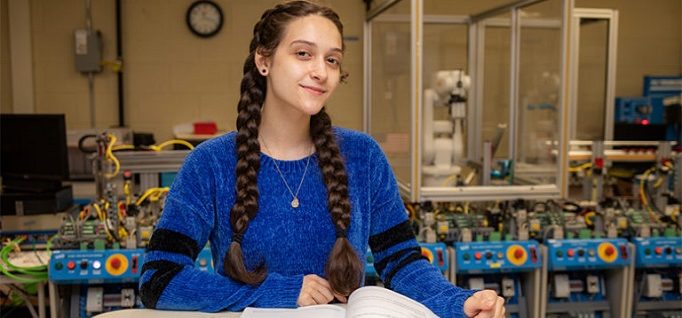Closing the gender gap in mechatronics
By Terry B. Bryson, Robin Lee and Scott Shasteen
January 19, 2022
A Tennessee college works to recruit females and minorities into high-wage, high-demand career fields
Men vastly outnumber women majoring in most STEM fields in college. Gender gaps are exceptionally and needlessly high in some of the fastest-growing and highest-paying jobs like mechatronics, robotics, cyber defense, math and health sciences. According to the National Girls Collaborative Project statistics, women represent only 28% of the workforce in science, technology, engineering and math (STEM).
As part of its student success and workforce development mission, Motlow State Community College in Tennessee, actively works to recruit females and minorities into high-wage, high-demand career fields like mechatronics.
“I chose to get a degree in mechatronics because I was looking for a new opportunity to make money,” said Victoria Rowell, a 2017 graduate of Motlow’s mechatronics program. “Many things these days are automated, and I wanted to know how to fix them.”
Rowell is one of a small, but growing percentage of women entering engineering career fields. Mechatronics engineering is a multi-disciplinary field that includes mechanical, electrical, systems design and controls engineering. Mechatronics technicians design computer-controlled electromechanical systems such as the robotics systems used in factories. It is a highly diverse field that allows technicians to have a strong foundation in many disciplines.
“When I was in college, my engineering program had only two women and 198 men,” said Melissa Paz, mechatronics instructor at Motlow. She graduated from Tennessee Technological University in 1988 with a degree in Industrial Technology from the College of Engineering. Paz now trains students in mechatronics and robotic skills for them to have rewarding, high-wage careers.
Paz strongly encourages women to join the ranks of upward mobility found in mechatronics and engineering.
“My degree replicates a lot of what mechatronics is. The field is hands-on with theory. I learned a lot of different manufacturing technologies such as woodworking, foundry applications, welding, CNC milling, and the upcoming technologies of programmable logic controllers (PLCs) and robotics. I also learned electrical, mechanical principles, and fluid power,” she added.
More women in the engineering fields
According to a November 2021 Washington Post article, the percentage of women majoring in engineering has grown from 9% in 1979 to 21% today.
“I truly believe the slow increase in the number of females in STEM fields is because it is not traditionally a women’s field. We need to introduce girls at a younger age to more STEM,” explained Paz. “I have talked to middle school children about engineering, and you can see the girls act like it is not a typical career for them. Society has to change and embrace women in non-traditional careers.”
Research has shown that career choice often begins in the middle school years and is influenced by parents, teachers, peers and the media. Institutions like Motlow can positively change the perception of the technology professions with an intentional effort to influence parents, teachers, students and children in their communities.
“It is important to have diversity in the mechatronics field,” said Bethany Millican, a current mechatronics student at Motlow. “There is nothing physically stopping women from being able to do this job, so it is crucial to let that be known to make the field more attractive to females. If you are smart and competent, you are suited for mechatronics.”
Motlow empowers women to achieve their highest potential in education and the workplace. Everyone has the same opportunities. We all benefit from increased diversity, greater creativity and innovation from a larger talent pool, more financial stability for families and a more robust economy at all levels.
“In this field, students learn theory and then apply it in a lab designed to reflect real-world scenarios,” said Paz, who before teaching worked for an automotive supplier where engineers designed, implemented, trained and troubleshot the product line.
Why some women choose mechatronics
Students come to mechatronics for a variety of reasons. Female students encourage others to explore what the field has to offer.
“I like mechatronics because it is hands-on and is very interesting to learn what goes on behind the scenes, seeing certain processes and how things run. I enjoy learning about all the software and programming aspects of the field,” said Alexis Clark, current mechatronics student at Motlow.
At Motlow, with just six classes, a student can get a mechatronics certification, known as Level 1 Certification. Level 2 is an associate of applied science (AAS) in mechatronics or AAS. in mechatronics with a robotics concentration. Certificate completers can start work immediately, or continue their education at Tennessee State University, Middle Tennessee State University or the University of Tennessee in Chattanooga for a bachelor’s degree.
“Our students typically enter the workforce to work as maintenance or engineering technicians,” Paz said.
There’s more to the story! Read the full article in CC Daily.



